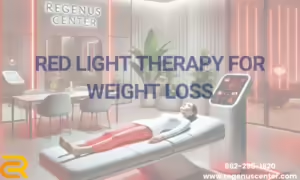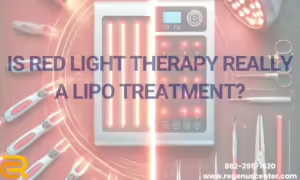Many people, especially women, visit Regenus Center for weight loss solutions, specifically targeting cellulite, sagging skin, and excess weight. We want to clarify the key differences between liposuction and red light therapy so you can choose which approach best suits your needs.
We do not provide liposuction at Regenus Center, only red light therapy photobiomodulation as part of a more engaged Bio Vitality Protocol at the core of a healthy, performance lifestyle that produces real results.
We’ve added notes alongside the scientific references, sharing our insights and opinions based on clinical experience and guiding hundreds of people through red light therapy protocols. These notes provide a practical perspective on the study claims, reflecting the real-world results we’ve observed at Regenus Center.
Let’s dive in.
Red light therapy (RLT) and liposuction are used for body contouring and fat reduction, but they fundamentally differ in their mechanisms, invasiveness, and outcomes. Here’s a detailed comparison between them, backed by scientific references.
1. Mechanism of Action
- Red Light Therapy:
RLT, also known as low-level laser therapy (LLLT), uses specific wavelengths of red and near-infrared light to penetrate the skin. These wavelengths stimulate the mitochondria in cells to increase energy production (ATP), which promotes fat cell shrinkage by triggering lipolysis. During lipolysis, stored fats (triglycerides) in fat cells are broken down into free fatty acids and glycerol, which are then released into the bloodstream for the body to use as energy.- Scientific Reference: A 2011 study published in the Journal of Obesity Surgery showed that RLT stimulates lipolysis in fat cells, reducing waist circumference. However, the fat cells themselves are not destroyed or removed. (this is true)
- Liposuction:
Liposuction is a surgical procedure in which fat cells are physically removed from the body. The surgeon inserts a small tube (cannula) under the skin through small incisions and suction out fat cells from targeted areas. This process permanently removes fat cells from the treated area.- Scientific Reference: A 2009 review in Aesthetic Plastic Surgery describes liposuction as a method for physically extracting fat cells from the body, which leads to immediate and permanent fat removal. (permanent is debatable unless a person has a lifestyle that does not further cause that problem)
2. Invasiveness
- Red Light Therapy:
RLT is completely non-invasive. It does not involve any cutting, needles, or anesthesia. The treatment is painless, with no downtime, and there is minimal to no risk of infection or scarring.- Scientific Reference: A 2016 article in Lasers in Surgery and Medicine describes RLT as a safe, noninvasive option for fat reduction with few side effects. (zero side effects)
- Liposuction:
Liposuction is an invasive surgical procedure that requires local or general anesthesia. It involves incisions, stitches, and a recovery period, during which patients may experience swelling, bruising, and discomfort. There is also a risk of complications such as infection, blood clots, or poor wound healing.- Scientific Reference: The American Society of Plastic Surgeons outlines that liposuction requires anesthesia, has a recovery period of several days to weeks, and carries risks associated with surgery, including infection and adverse reactions to anesthesia.
3. Results and Effectiveness
- Red Light Therapy:
RLT can reduce fat by shrinking fat cells, but the results are gradual. It may take several sessions over weeks or months to see noticeable changes in body contouring. The results are temporary unless combined with lifestyle changes like diet and exercise to maintain fat loss. RLT doesn’t remove fat cells; it just reduces their size.- Scientific Reference: A study in Photomedicine and Laser Surgery (2013) found that multiple sessions of RLT led to a significant reduction in body circumference measurements over several weeks, but the results were not as immediate or dramatic as surgical methods. (this is true)
- Liposuction:
Liposuction offers immediate and dramatic results because fat cells are physically removed from the body. The fat reduction is permanent for the treated areas, as the removed fat cells do not grow back. However, if the patient gains weight after the procedure, fat can accumulate in other body areas.- Scientific Reference: A 2017 review published in Plastic and Reconstructive Surgery cites liposuction as providing rapid and noticeable fat reduction, with long-lasting results when maintained through a healthy lifestyle.
4. Recovery Time
- Red Light Therapy:
Since RLT is noninvasive, there is no recovery time. Patients can immediately return to their normal activities after a session. Physical activity is not restricted, and no pain or discomfort is typically reported after the procedure.- Scientific Reference: Lasers in Surgery and Medicine (2016) reported that patients treated with RLT experience no downtime and can continue their regular activities right after treatment.
- Liposuction:
Liposuction typically requires a recovery period of several days to weeks, depending on the extent of the procedure. Patients may need to wear compression garments to minimize swelling and avoid strenuous activities for a time. Bruising and soreness are common post-surgery.- Scientific Reference: The American Society of Plastic Surgeons notes that recovery from liposuction can take up to several weeks, with most patients needing 1-2 weeks off from work and normal activities.
5. Risks and Side Effects
- Red Light Therapy:
RLT has minimal side effects, the most common being mild redness or warmth in the treated area. There is no risk of infection or scarring, and it is considered safe for most individuals, including those with underlying health conditions.- Scientific Reference: A 2013 study in Photomedicine and Laser Surgery reviewed the safety of RLT and concluded that the therapy is well-tolerated with no significant adverse effects reported.
- Liposuction:
Liposuction carries typical surgical risks, including infection, blood clots, and anesthesia-related complications. Other possible side effects include uneven fat removal, skin irregularities, and nerve damage. Scarring is also possible where incisions are made.- Scientific Reference: A 2017 article in Plastic and Reconstructive Surgery lists potential risks such as infection, hematomas, and unsatisfactory cosmetic outcomes following liposuction.
6. Cost
- Red Light Therapy:
RLT sessions are generally much less expensive than liposuction. However, multiple sessions are usually required to see noticeable results, which can increase the overall cost. On average, a session of red light therapy costs between $50 and $200, depending on the location and provider.- Scientific Reference: According to Lasers in Surgery and Medicine (2016), red light therapy treatments are affordable but often require several sessions for visible results.
- Liposuction:
Liposuction is a one-time procedure but tends to be much more expensive, ranging from $3,000 to $10,000, depending on the treatment area and the surgeon’s expertise.- Scientific Reference: The American Society of Plastic Surgeons reports that liposuction is one of the more expensive fat reduction procedures due to the cost of surgery, anesthesia, and follow-up care.
Conclusion:
Red light therapy for weight loss and liposuction offer ways to reduce body fat, but they differ significantly in their approach. RLT is non-invasive, requires no recovery time, and works by temporarily shrinking fat cells, while liposuction is invasive, removes fat permanently, and involves a significant recovery period. In both cases, you need a healthy, performance lifestyle to maintain and sustain results





